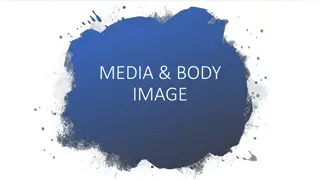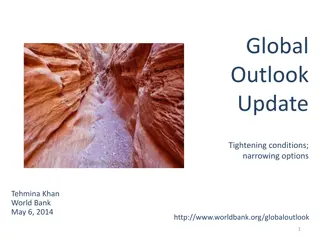Insights into the Global Media Monitoring Project and OIC Countries
The Global Media Monitoring Project (GMMP) aims to analyze the portrayal of women in mainstream news media worldwide. Conducted in 114 countries, including 27 OIC member states, the GMMP collects data on gender indicators in news coverage. The findings reveal disparities in the representation of women, with the gender gap narrowing in some regions but challenges persisting in areas such as women's economic participation and portrayal as survivors of domestic violence.
Download Presentation

Please find below an Image/Link to download the presentation.
The content on the website is provided AS IS for your information and personal use only. It may not be sold, licensed, or shared on other websites without obtaining consent from the author.If you encounter any issues during the download, it is possible that the publisher has removed the file from their server.
You are allowed to download the files provided on this website for personal or commercial use, subject to the condition that they are used lawfully. All files are the property of their respective owners.
The content on the website is provided AS IS for your information and personal use only. It may not be sold, licensed, or shared on other websites without obtaining consent from the author.
E N D
Presentation Transcript
+ The Global Media Monitoring Project and the OIC Countries By: Maha Akeel, Director of Information Department, OIC
+The Global Media Monitoring Project (GMMP) Goals: To map the representation and portrayal of women in the world s mainstream news media To develop a grassroots research instrument To build solidarity among gender and communication groups worldwide To create media awareness To develop media monitoring skills on an international level
+The Global Media Monitoring Project (GMMP) The GMMP collects data on indicators of gender in the news, such as: the presence of women, gender bias, and stereotyping. The most recent study, conducted in 2015, encompassed 114 countries. Out of those 27 are OIC member states (Afghanistan, Benin, Bangladesh, Burkina Faso, Cameroon, Chad, Egypt, Gabon, Guyana, Indonesia, Kyrgyzstan, Lebanon, Malaysia, Mali, Mauritania, Morocco, Niger, Nigeria, Pakistan, Palestine, Senegal, Sierra Leone, Sudan, Suriname, Tunisia, Turkey, Uganda).
+Coverage The 1995 Report covered 71 countries, and was conducted by volunteers over the span of one day. Consequent studies took place in 2000 and covered 70 countries, in 2005 covering 76 countries, in 2010 in 108 countries and in 2015 in 114 countries. All of the monitoring and compiling of reports is carried out by volunteers. The 2015 Project covered 22,136 news items, 26,010 news personnel, and 45,402 total news subjects in newspaper, radio, television, internet news and news media tweets in one specified day (March 25). The research discussed news subjects, personnel and content through the framework of media accountability to women.
+Findings: News Subjects Women make up only 24% of the persons heard, read about or seen in newspaper, television and radio news, exactly as they did in 2010. Over the past two decades, the gender gap in people in the news has narrowed most dramatically in Latin America by 13 percent. Women are three percent less visible in political news stories now than five years ago. They comprise 38% of people interviewed on the basis of personal experience compared to 31% in 2005.
+Findings: News Subjects North America has the highest percentage of women experts in the news (32%), followed by the Caribbean (29%) and Latin America (29%). In 2015, progress towards news representation that acknowledges women's participation in economic life remain elusive: While women in the real world hold at least 40% of paid employment globally, in the news world only 20% of the workers in the formal labor force are women, while 67% of the news world unemployed and stay-at-home parents are women. Portrayals of women as survivors of domestic violence have risen by more than four times across the period 2005 to 2015.
+Findings: Reporters and Presenters The 2015 GMMP detected what appears to be a global glass ceiling for female news reporters as far as they are visible in newspaper bylines and newscast reports. Women have consistently reported only 37% of the news over the past decade from 2005 to 2015. Women as news reporters are most present on radio, at 41%, and least in print news, at 35%. Younger presenters on screen are predominantly female, but the scales tip dramatically at 50 years old when men begin to dominate the news-anchoring scene. At 65 years and older, women disappear from the screen as reporters and presenters.
+Findings: News Content 9% of stories overall contain reference to legal, rights or policy frameworks, with social and legal stories making the highest contribution to the global average. A rights angle is barely present is political and economic stories. 97% of political stories in Asia, 98% of economic stories in the Pacific region and the Middle East perform poorly on the rights-focus yardstick. 14% of stories by female reporters focus centrally on women, in contrast to 9% of stories by their male counterparts.
+Findings: News Content 9% of stories evoke gender equality or inequality issues, more than double the percentage documented in 2005. Only 4% of stories clearly challenge gender stereotypes, a one percent change since 2005.
+Findings: Digital News Women's relative invisibility in traditional news media has crossed over into digital news delivery platforms: Only 26% of the people in internet news stories and media news tweets combined are women. Women report five percent more stories online than in the traditional mediums combined: 42% of online news are reported by women. Gender difference in source selection by female and male reporters becomes starker in online news: Women are 33% of sources in stories by online news female reporters, compared to 23% in stories by men. Only 4% of news media tweets clearly challenge gender stereotypes, exactly similar to the overall percentage of print, radio and television stories that challenge such stereotypes.
+Implications The GMMP 1995 - 2015 findings paint a picture in which unequal gender power relations are entrenched and validated, and in which gender stereotypes are replicated and reinforced by the world's news media. That the patterns of underrepresentation, misrepresentation and invisibilization of women have continued into the digital news world show that the problem is deeply entrenched in the mainstream news media system irrespective of the platform through which news are channeled.
+Why is it important? The media are a powerful force in shaping how we see the world, what we think and how we react and make decisions. How women are represented and reflected in the media indicate their position and status in society, which is what OPAAW is about. Empowering women in the political, economic and social fields would not be complete without empowering her in and through the media.
+The OIC Women in the Media Monitoring Center: Encourage more member states to participate in the GMMP for the next report in 2020. SESRIC will conduct training workshops for the member states on how to monitor and report women s presence in the media. A progress report will be presented every two years to the Information Ministers Conference. The center will regularly collect data and reports about women from the member states and issue press releases for dissemination.























